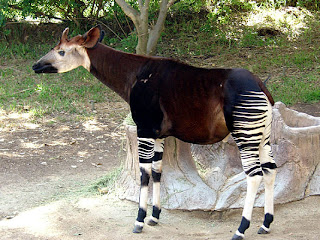True Wild Life | Okapi | The okapi is one of the last remaining ancestors of the common giraffe, despite the fact that the striking markings of the okapi give the okapi can almost zebra like appearance. The okapi is native to the Ituri Rainforest, a 63,000 square kilometer rainforest that is located in the Democratic Republic of the Congo, in the North East Africa. Around a fifth of the rainforest is made up of the Okapi Wildlife Reserve, which is a World Heritage Site.
The okapi is a herbivorous animal that spends its time rummaging for tasty treats to munch on. The okapi eats more than 100 different types of plant includes leaves, grasses, buds, shoots, fruits and even fungi. Many of the plants that the okapi feed on would be poisonous if ingested by humans. The okapi has a red-brown coloured coat of fur with horizontal white striped markings, that are found on the legs of the okapi. The okapi develop these extraordinary markings at a young age, as the white stripes of the okapi are thought to give the okapi good camouflage from predators in the dense African jungle.
The main predator of the okapi is the leopard, an animal that spends a lot of time resting in the trees and surveying the surrounding area for potential prey. Other predators of the okapi include wildcats such as the serval, and the human hunters in the area. The okapi has large ears which enables the okapi to detect approaching predators with enough time for the okapi to get away and hide. The okapi also has an impressively long tongue, with the okapi being one of the few animals in the world that is able to lick its own ear!
Okapi are active during the day meaning that the okapi is diurnal. The okapi spend their waking hours foraging for food. As well as the plants that the okapi eat, they also eat a reddish clay that provides essential salt and minerals to the plant based diet of the okapi. Okapi are generally not sociable animals and okapi do not seek companionship. However okapi may occasionally feed together in small groups for a short period of time. Okapi prefer to live alone in large, secluded areas.
Male and female okapi come together briefly to mate, then go their separate ways. Female okapi take themselves deep into the forest to give birth to their young. A mother okapi usually gives birth to one baby okapi at a time, and this baby okapi will remain hidden in the nest of foliage for the first couple of months. The mother okapi return to the baby okapi to allow it to nurse and she will then wean her offspring at about 6 months of age. However, the baby okapi will not reach full size until it is about 3 years old.





No comments:
Post a Comment